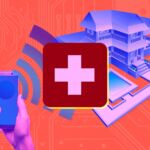
As the first fall semester of the Covid-19 era gets underway, K-12 schools and universities are struggling to operate safely. Many are already seeing outbreaks and disruptions of their return-to-class plans, despite the safety measures they’ve put in place. Because of human nature and the risk-taking tendencies of young adults, the existing safety measures on their own may not provide enough protection for students, staff, and communities. Extra facility monitoring resources can help overburdened school officials identify problems like large gatherings and quarantine violations in real-time, not later when social media posts circulate.
Some recent outbreaks have been traced to students who violate school rules about large gatherings. To prevent the wider spread of outbreaks that begin on college campuses, National Institute of Allergy and Infectious Diseases director Dr. Anthony Fauci now recommends that colleges avoid sending students home if there’s an outbreak.
Meanwhile, at K-12 schools around the country, there are cases of students and teachers bringing the virus from home. Proper distancing on campus is critical to prevent these cases from spreading, even though safe distancing reduces the number of students attending in-person classes.
Schools, of course, weren’t set up to enforce distancing and quarantine rules. Adding staff to enforce safety measures is a cost that’s not in the budget for many schools. Asking current staff to take on high stakes monitoring tasks is stressful and impractical because it pulls those employees away from their core duties and can put their health at risk.
More “Eyes and Ears” to Protect Students and Staff
How can schools improve their safety and monitoring procedures quickly and cost-effectively? Enhanced facility monitoring with inexpensive wireless sensor systems can help with physical distancing and quarantine monitoring.
On university campuses and in K-12 schools, one of the major challenges is reducing the risk of outbreaks. Physical distancing is one of the best practices to prevent an infected student or staffer from spreading the virus. As the headlines show, however, getting students to maintain safe distances can be consistently difficult.
Low-cost wireless sensor networks can help resident advisors, housing managers, and security staff monitor classrooms and campus common areas like dining halls, lobbies, and corridors. A network of quick-to-install door sensors, motion detectors, and wireless video cameras can monitor traffic flow through hallways, movement in classrooms, and gatherings in common areas. All the data is sent to a secure on-site gateway that relays the sensor data to the cloud, where authorized staffers can see in real-time where the areas of highest activity are.
For example, if a door to a common room that’s supposed to remain closed overnight is repeatedly opened and closed, that could indicate a possible gathering in violation of safety rules. When a staffer sees that door sensor activity, they can also check images from the wireless video camera in the common room. Based on their view of what’s happening, they can decide whether someone needs to go clear the room or not.
To keep campus staff members from monitoring the sensor dashboard continuously, they can set thresholds for sensor activity that generate alerts. That way, if there’s more motion than is safe in a hallway between classes, for example, staffers can get an alert on their phone or via email. They can then access the video feed for that area and go in person to move some students out of the area if there’s overcrowding.
Wireless sensor systems also save and analyze all the data they collect. Over time that information can reveal patterns that show school officials which parts of campus are hot spots for crowding. With this information, staffers can focus on fixing traffic flow and access to the most problematic parts of campus first, for the biggest impact on safety.
Improved Safety Practices
Quarantine for college and university students presents another challenge. Whether they’re imposed as a precaution when students arrive on campus or in response to a campus outbreak, ensuring that students follow the rules is critical to preventing the spread of infection.
Wireless sensors can help schools quickly set up reliable facility monitoring of quarantine housing. The same types of sensors that can help with physical distancing — door sensors, motion detectors, and video monitors — can be installed in a dormitory or health center in a matter of hours. That can help school officials detect rule violations as they happen rather than after the fact when it’s too late to prevent possible transmission to a larger group of students.
Knowing that infractions will be detected in real-time could discourage students from taking the risk of breaking quarantine. It could also allow schools to issue students a warning before suspending or expelling them for putting others at risk.
Another Layer of Safety Measures
When used with other pandemic-related best practices such as masking and proper distancing and cleaning, remote wireless monitoring equipment can provide an additional layer of preventive measures. Wireless monitoring in real time can also save overworked staffers’ time so they can focus on their jobs. And having a sensor system up and running can demonstrate to students, faculty members, staffers, parents, and members of the surrounding community that school administrators are committed to reducing the spread of the coronavirus.




 Related Podcast Episode
Related Podcast Episode




 Related Applications
Related Applications


 Latest IoT News
Latest IoT News









